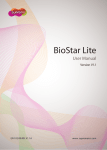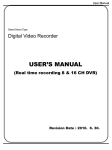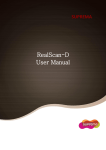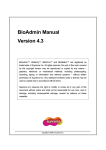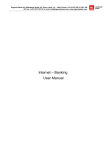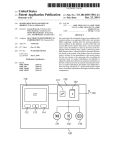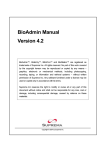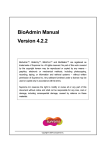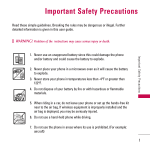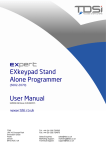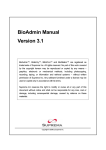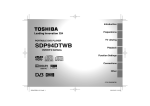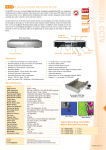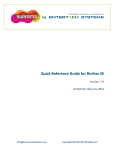Download BioStar Lite Manual
Transcript
BioStar Lite
User Manual
Version V1.0
www. supremainc.com
Quality Assurance
Warranty
Suprema warrants the performance of the product specified in the specifications within
the limitations set forth for a warranty period of one year from the date of delivery to the
purchaser. If the purchaser claims any defects covered in this warranty in writing within the
warranty period, then Suprema will repair or replace and deliver the defective product that
is returned within the warranty period; provided that the purchaser shall be responsible
for any transportation cost (including insurance for overseas shipping). This warranty does
not apply to: (1) damage caused by strong external physical impact, overcurrent, misuse,
abuse, or negligence; (2) damage to the product that has been improperly repaired,
remodeled, or modified without the written permission of the provider; or (3) damage to
the product that has been installed or used contrary to the manual provided by Suprema.
Claims for any defects must be submitted to Suprema in writing by using the Return
Material Authorization Report provided by Suprema within 30 days of the finding of the
defect or within 1 year from the date of delivery. The Return Material Authorization Report
must include the detailed information, model number, invoice number, and serial number
of the defective product. A product without the return authorization number issued by
Suprema is not considered to be eligible for the warranty. All defects must be reproducible.
Excluding the above-mentioned warranties and remedies, this product is provided as-is
without any expressed or implied warranties regarding product warranty, commercial
viability, or availability for a particular purpose.
2
Quality Assurance
Disclaimer
The information in this document is provided in connection with Suprema products. No
license, expressed or implied, by estoppels or otherwise, to any intellectual property rights
is granted by this document, except as provided in Suprema's Terms and Conditions of
Sale for such products. Suprema assumes no liability whatso ever and Suprema disclaims
any expressed or implied warranty, relating to sale and/or use of Suprema products,
including liability or warranties relating to fitness for a particular purpose, merchantability,
or infringement of any patent, copyright, or other intellectual property right. Suprema
products are not intended for use in medical, life saving, or life sustaining applications or
other applications in which the failure of the Suprema product could create a situation
where personal injury or death may occur. Should Buyer use Suprema products for any
such unintended or unauthorized applications, Buyer shall indemnify and hold Suprema
and its employees, head quarters, subsidiaries, affiliates, and distributors harmless against
all claims, costs, damages, expenses, and reasonable attorney fees arising out of, directly
or indirectly, any claim of personal injury or death associated with such unintended or
unauthorized use, even if such claim alleges that Suprema was negligent regarding
the design or manufacture of the part. Suprema reserves the right to make changes
to specifications and product descriptions at any time without notice to improve
reliability, function, or design. Designers must not rely on the absence or characteristics
of any features or instructions marked "reserved" or "undefined." Suprema reserves
these for future definitions and shall have no responsibility whatsoever for conflicts or
incompatibilities arising from future changes to them.
3
Contents
Quality Assurance .....................................2
Chapter 1
Adding or Modifying
an Administrator Account ........... 22
Getting Started............................... 8
Deleting an Administrator
Account .............................................. 23
Features ........................................................8
Logout................................................. 23
Key Features................................................9
Chapter 3
Connecting and Executing.................. 10
Using the Home Menu................. 25
Chapter 2
Screen View............................................... 25
Using Basic Menus........................ 12
Using Quick Menus................................ 26
Screen View............................................... 12
Chapter 4
Device Management............................. 14
Using the User Menu.................... 28
Adding Devices................................ 14
Screen View .............................................. 28
Viewing the Device
Information....................................... 15
Searching Users ...................................... 29
Door Management................................. 17
Adding Doors................................... 17
Modifying Door Information....... 19
Closing Doors................................... 20
Opening Doors................................. 20
Setting a Language................................ 21
Viewing the Help Manual.................... 21
New User Registration.......................... 30
Entering General Information..... 31
Registering a Card .......................... 32
Scanning a Fingerprint ................. 32
User Information Modification ......... 33
Updating General Information... 34
Modifying Card Information....... 34
Modifying Fingerprint................... 34
Checking the BioStar Lite Firmware
Version........................................................ 21
Administrator Account
Management............................................ 22
4
Contents
Chapter 5
Setting Popup Timeout................. 49
Using the Log Menu..................... 36
Setting Backlight Timeout........... 49
Monitoring Event Logs ........................ 36
Setting Show Central Clock
Display................................................. 49
Search Logs............................................... 37
Screen View ...................................... 37
Search Logs....................................... 38
Chapter 6
Setting Data Format....................... 49
Setting Volume................................ 49
Setting Card or Fingerprint
Options....................................................... 50
Using the Device Menu................ 42
Setting a Card Option.................... 51
Authentication Mode
Configuration........................................... 42
Setting a Fingerprint Option....... 51
Setting Fingerprint
Authentication................................. 43
Setting Card Authentication....... 43
Setting ID Authentication ........... 43
Setting Other Options................... 43
Chapter 7
Using the Access Control Menu... 54
Screen View .............................................. 54
Holiday Group Managment................ 55
Adding a Holiday............................. 55
Setting Network ..................................... 44
Modifying a Holiday....................... 56
Setting IP Address........................... 45
Delete a Holiday ............................. 56
Setting WLAN................................... 45
Setting Serial..................................... 46
Setting Display and Sound
Options....................................................... 47
Setting Time...................................... 48
Setting Language............................ 48
Setting Background....................... 48
Setting Theme.................................. 48
Setting Menu Timeout.................. 49
Timezone Management....................... 57
Adding a Time Zone....................... 57
Modifying a Time Zone................. 58
Deleting a Time Zone.................... 59
Access Group Management................ 60
Adding an Access Group.............. 60
Modifying an Access Group........ 61
Deleting an Access Group............ 61
5
Contents
Chapter 8
Using the System Profile Menu.... 63
Screen View .............................................. 63
System Configuration
Management............................................ 64
Backup System Configuration ... 64
Restore System Configuration.... 64
User Information Management......... 65
Appendix....................................... 68
Understanding the Product
Details ........................................................ 68
Introducing Devices Supporting
BioStar Lite......................................... 68
Notes for Authenticating
Fingerprints on the Device.......... 69
Authentication Mode Supported
by Devices.......................................... 70
Backup User Information.............. 65
Detailed Diagram ................................... 71
Restore User Information............. 65
Device Connections....................... 71
Language Resource Management... 66
Door Connections........................... 72
Download Language Resource.. 66
Troubleshooting ..................................... 73
Upload Language Resource........ 66
Glossary...................................................... 74
Index............................................................ 76
6
Chapter
1
Getting Started
Features
Key Features
Connecting and Executing
Getting Started
Features
yy Distributed Intelligence Access Control System
Suprema's distributed intelligence approach requires less hardware and less wiring
than the conventional, centralized access control systems. User information, access
rules, and other data can be distributed to each device to speed up authorization time
and provide continual operation even when the network connection is cut off.
yy Combination of Conventional Access Control and Biometrics
Compared to conventional access control systems, this product was further developed
to support biometric identification and access card configuration features.
yy Convenient Network Connection that Supports Both TCP/IP and RS485
Devices can be either connected via Ethernet or wirelessly to a local area network or
directly connected via serial connections (RS485).
yy High-level Access Security Controls
In order to provide access control with higher level security, Suprema's access control
devices incorporate state-of-the-art fingerprint recognition algorithms that won two
consecutive first-place awards in the fingerprint authentication contest (FVC2004 and
FVC2006).
8
Getting Started
Key Features
BioStar Lite is a system suitable for a small-sized access control environment with less than
10 devices, which provides a convenient, easy access control management to the user via
a simple and intuitive UI.
yy Managing Users
BioStar Lite provides features for searching, adding, deleting, and modifying users
according to the user information registered on the devices with an operating webserver. Any changes from adding/modifying/deleting the user will be applied to all
devices on the BioStar Lite system. Please refer to 'Using the User Menu' for details
regarding managing users.
yy Managing Event Logs
BioStar Lite supports real-time monitoring and searching for event logs. Log
monitoring and search are available on all devices on the BioStar Lite system.
yy Managing Access Group
BioStar Lite supports 32 holiday schedules, 128 time frames, and 128 access groups.
Each time frame can be set with 5 time periods for each day of the week or 5 time
periods for 2 holiday schedules selected from 32 schedules.
Each access group consists of a total of 32 'time frames per device.
A user in a particular access group can be authenticated within the time frame
registered on a device belonging to a corresponding access group.
Any changes from adding, modifying, or deleting access control items will be applied
to all devices on the BioStar Lite system. Please refer to 'Access Group Management'
for details regarding the access group.
yy Managing Doors
Up to 10 doors can be remotely controlled with BioStar Lite. 2 devices can be installed
in a door, which can be remotelly opened or closed by the BioStar Lite. Please refer to
'Door Management' for details regarding managing doors.
9
Getting Started
yy Managing Devices
The administrator can set the settings of up to 10 devices with BioStar Lite. Also, the
administrator can adjust settings such as an authentication mode, communication
settings, actions, screens, and sounds. All settings regarding the operating mode,
display, volume, or fingerprint options modified on BioStar Lite will be applied to all
devices on the BioStar Lite system. Please refer to 'Using the Device Menu' for details
regarding managing devices.
Connecting and Executing
Connection and execution are available on devices that have a BioStar Lite server.
1Press Menu > Network > TCP/IP > Use BioStar Lite.
2Press Menu > Network > TCP/IP and check IP address currently set in the device.
NOTE
• The default value is 127.0.0.1’ If the IP address in the device is set as ‘127.0.0.1’, ask
network administrator for the IP setup.
3
Enter IP address to Web browser such as Internet Explorer or Chrome.
4
Check if BioLite Net is connected to the associated device correctly.
If at least one login user is registered, a login screen is displayed when accessing
BioStar Lite. When logging in as a registered user, the Home screen is displayed.
NOTE
• Only one concurrent connection can be allowed for BioStar Lite.
10
Chapter
2
Using Basic Menus
Screen View
Device Management
Adding Devices
Viewing the Device Information
Door Management
Adding Doors
Modifying Door Information
Closing Doors
Opening Doors
Setting a Language
Viewing the Help Manual
Checking the BioStar Lite Firmware Version
Administrator Account Management
Adding or Modifying an Administrator Account
Deleting an Administrator Account
Logout
Using Basic Menus
Screen View
1
2
3
4
5
6
9
7
8
1 Menu Button: Go to the relevant menu by clicking a menu button from different
menus.
yy Home: Go to the Home menu.
yy User: Go to the User menu.
yy Log: Go to the Log menu.
yy Device: Go to the Device menu.
yy Access Control: Go to the Access Control menu.
yy System Profile: Go to the System Profile menu.
2 Language Button: Set a language to be displayed on the screen.
3 Help Button: View Help for the relevant menu.
12
Using Basic Menus
4 Account Button: View or modify an account to log in to BioStar Lite, or register a
new account.
5 Version Button: Check the firmware version of the BioStar Lite.
6 Logout Button: Log out from the system if logged in with a registered account.
7 Menu Activation Window: A menu screen is displayed when each menu button is
pressed.
8 Door Management Window
yy Close: Remotely select and close a door.
yy Open: Remotely select and open a door.
yy Setup: Modify the information of the registered door.
yy Add: Add doors to be controlled to the system.
9 Device Management Window
yy Info: View the detailed information of a device.
yy Add: Search and add a device connectable with BioStar Lite.
13
Using Basic Menus
Device Management
From the device list, you can view devices that are connected to BioStar Lite.
Before adding devices, write down the location, ID, and IP address of each device so as to
easily add devices. Static IP addresses are recommended for devices to be connected with
BioStar Lite.
Adding Devices
1Click Add. A pop-up window for searching devices is displayed.
2
Select a desired search method.
yy UDP Search: Displays all devices available on the same network.
yy TCP Search: Searches devices by entering the IP address and port.
yy RS485 Search: Searches devices connected via RS485.
14
Using Basic Menus
3
From the list of devices found, check the desired device(s).
4Click OK. The selected device will be displayed on the list.
5
Click the red icon that appears beside the registered device(s) to synchronize the
device.
NOTE
• In synchronizing the settings for the users, the connected devices and the access
groups are synchronized. The settings for the users, connected devices, and access
groups are synchronized.
• A maximum of 9 sub-devices can be registered into the BioStar Lite.
Viewing the Device Information
1
From the device list, select a desired device.
The selected device will be displayed in blue.
Refer to the 'Device Connections (Page 71)' for details on connecting devices.
15
Using Basic Menus
2Click Info to view the detailed device information.
3
You can perform the Factory Reset, Upgrade, Reboot, Remove, or Check Status.
yy Factory Reset: Initializes the device tio it's factory defaults (Does not affect log
or user data).
yy Upgrade: Upgrades the firmware.
i.Click Upgrade.
ii.Click Browse and select a path where the latest firmware is saved.
iii.Click Apply to upgrade to the selected firmware.
Click Cancel to cancel upgrade.
yy Reboot: Reboots the device.
yy Remove: Removes the selected device from the device list.
yy Check Status: Tests the network connection to the device.
4
You can change the name of the device on the Device Detail screen.
5Click Apply to save any changes.
Click Cancel to close the pop-up window.
NOTE
• Click [X] on the top right corner in order to close the pop-up window.
16
Using Basic Menus
Door Management
The door list contains a list of all the registered doors with their respective devices. It will
indicate teh status of a door if it was manually controlled.
Refer to the 'Door Connections (Page 72)' for details regarding door information.
Adding Doors
1Click Add. A pop-up window for adding doors is displayed.
2
Enter a desired door name.
17
Using Basic Menus
3
Configure the door.
yy Entry: Sets the device to control entry into the room/building.
yy Exit: Selects a device control exit from a room/building.
yy Relay: Sets a door relay.
yy Duration (sec): Sets a duration (sec) for the door to be held open.
After the period, the relay will become deactivated.
yy RTE: Sets an input trigger to open the door.
yy RTE Type: Sets an input type to be used for the RTE (Request to Exit).
(N/C: Normally Closed or N/O: Normally Open)
yy Door Sensor: Sets a sensor input that detects the door status.
yy Door Sensor Type: Sets an input type to be used for the door sensor.
(N/C: Normally Closed or N/O: Normally Open)
yy Held Open Time (sec): Sets a duration (sec) a door must remain open for an
alarm to trigger.
yy Unlock Time: Sets a scheduled time when the door will remain unlocked.
yy Lock Time: Sets the schedule when the door will remain locked.
yy Use Anti-passback: Enables or disables the APB (anti-passback) feature.
4Click Add to register the new door in the door list.
Click Cancel to close the window.
NOTE
• A red icon appears after a door is initially added. Click the red icon to synchronize the
settings for the added device with the user's information.
• APB (anti-passback) is a feature to limit the access of users with no entrance or
departure record. Therefore, this feature distinguishes 'IN Devices' and 'OUT Devices'
and allows only users authenticated on the 'IN Device' to be authenticated on the
'OUT Device' and vice versa.
• The APB (anti-passback) feature can be set only if a device is installed on both the
inside and outside of the door.
18
Using Basic Menus
Modifying Door Information
1
From the Door List, select a desired door.
The selected door will be displayed in blue.
2Click Setup. A window for changing the door will be displayed.
3
Update the desired field.
yy Refer to the 'Adding Doors (Page 17)' section.
4
You can change the door name on the Door Information screen.
5Click Apply to update the door information.
Click Remove to remove the selected door from the door list.
Click Cancel to close the window.
19
Using Basic Menus
Closing Doors
You can remotely close doors.
1
From the door list, select a desired door.
2Click Close to close the selected door.
Opening Doors
You can remotely open doors.
1
From the door list, select a desired door.
2Click Open to open the selected door.
NOTE
• The door relay which is remotely opened by the Open button on the BioStar Lite, will
be held open unless it is closed by the Close button.
20
Using Basic Menus
Setting a Language
You can set a language to be displayed on the BioStar Lite screen.
1Click Language. A window for setting a language is displayed.
2Select English, Korean, or Custom.
3Click Apply to use the selected language on the displayed screen.
Click Cancel to cancel setting a language.
Viewing the Help Manual
You can view help manuals on the corresponding menu screen by clicking Help.
Checking the BioStar Lite Firmware Version
You can check the BioStar Lite Firmware version by clicking Version on the top right of
the screen.
21
Using Basic Menus
Administrator Account Management
You can view the registered login users by clicking Account.
Adding or Modifying an Administrator Account
1Click Account on the top right of the screen. A window for adding an account is
displayed.
2
Enter an administrator ID.
3
Enter the name of administrator.
4
Creat a password.
5
Re-enter the password to confirm.
6Click Add/Modify to register or update an administrator account.
NOTE
• If you forget an account, you should reset the device that has a BioStar Lite server.
• When a BioStar Lite equipped device is reset, all of the door and device information
are removed.
22
Using Basic Menus
Deleting an Administrator Account
1Click Account on the top right of the screen.
A window for changing an account is displayed.
2
Check the desired account(s).
3Click Delete to delete the selected accounts.
NOTE
• If no administrator account registered on the list, the BioStar Lite will automatically
enter into the Home menu.
• If at least one login user is registered, a login screen is displayed when you access
BioStar Lite. You return to the Home screen after the registered user is logged in.
• A maximum of 5 BioStar Lite administrator accounts can be created. Then login ID can
only include the numbers from 1 to 4294967295.
Logout
1Click Logout on the top right of the screen.
NOTE
• In order to logout an BioStar Lite, administrator account must be created.
23
Chapter
3
Using the Home Menu
Screen View
Using Quick Menus
Using the Home Menu
Screen View
1
2
1 Home Menu Button: Go to the Home menu by clicking this button from a different
menu.
2 Quick Icon: Click an icon to go to the relevant menu.
25
Using the Home Menu
Using Quick Menus
Select a quick menu icon to go to the relevant menu.
yy Add, delete, or modify a user.
yy Search a user.
yy View event logs of all devices in real-time.
yy Search event logs by period, user, or device.
26
Chapter
4
Using the User Menu
Screen View
Searching Users
New User Registration
Entering General Information
Registering a Card
Scanning a Fingerprint
User Information Modification
Updating General Information
Modifying Card Information
Modifying Fingerprint
Using the User Menu
The user management submenu is used to add, modify, or delete users within the user
database. Updates to the user database will be applied to all the devices registered into
the BioStar Lite.
Screen View
1
2
3
4
7
6
5
1 User Menu Button: Go to the User menu by clicking this button from a different
menu.
2 Information Window: View the total number of registered users and fingerprints.
3 User List: View a list of registered users on the system and their relevant information.
4 Delete All Button: Delete all registered users on the system.
5 Delete Button: Delete selected users from the user list.
28
Using the User Menu
6 New User Registration Button: Register a new user's information on the system.
7 Search Button: Search registered users on the system.
NOTE
• When you click ID or Name among item titles at the top of the user list, users are
sorted by ID or name.
• You can view ID, name, card ID and more on the user list.
• You can view or modify the user's general information by clicking a user from the user
list.
• You can delete the selected user by clicking Delete.
• You can delete all registered users by clicking Delete All.
Searching Users
1Click Search. A window for searching for a user is displayed.
2
Select a name or ID from the user drop-down menu.
3
Enter a the respective name or ID.
4Click Search to display the search results.
Click Cancel to close the window.
29
Using the User Menu
New User Registration
1Click New to begin registration.
2
Enter general information.
3
Enter card information. (This step can be skipped.)
4
Scan a fingerprint. (This step can be skipped.)
5Click Add to register the new user.
Click Cancel to cancel registration.
NOTE
• Refer to from page 31 to page 32 for details on entering general inforamtion and
card information, and scanning fingerprints.
30
Using the User Menu
Entering General Information
1
Enter a numerical ID.
2Click Check ID to check for ID availability.
If not, the pop-up message for checking ID is displayed.
3
Enter a name.
4
Enter a desired PIN number.
5
Re-enter the PIN number to confirm.
6
Set a desired user level to Normal or Admin.
7
Set a private authentication mode. This mode will be prioritized over the device's
default settings. Refer to 'Authentication Mode Configuration (Page 42)' for details.
8
Set an access group for the user.
Each user can be a part of 4 different access groups.
NOTE
• A user in a particular access group can be authenticated within the time frame set on
a device belonging to a corresponding access group. Refer to Chapter 7 'Using the
Access Control Menu (Page 53)' for details regarding the access group.
31
Using the User Menu
Registering a Card
1Click Read to register a card.
2
Follow the instructions displayed on the linked device.
If the scan is successful, the card ID will be displayed on the BioStar Lite.
3Click Delete to delete the entered card ID.
Scanning a Fingerprint
1Click Scan to register a fingerprint.
2
Follow the instructions displayed on the linked device. This process is repeated twice.
3
To register an additional fingerprint, repeat steps 1 and 2.
Please refer to 'Notes for Authenticating Fingerprints on the Device (Page 69)'
for details regarding registering fingerprints.
4Click Add to register the scanned fingerprint.
Click Cancel to cancel registering the scanned fingerprint.
NOTE
• Upon success, an image of the fingerprint will be displayed.
• Click Delete next to the scanned fingerprint to delete corresponding fingerprint.
32
Using the User Menu
User Information Modification
1
Click on a desired user from the user list.
2
Update general information.
3
Update card information.
4
Update a fingerprint information.
5Click Apply to apply the change.
Click Cancel to cancel the change.
33
Using the User Menu
Updating General Information
Refer to the section on 'New User Registration'.
NOTE
• When modifying the general information, you cannot modify the user ID.
Modifying Card Information
Refer to the section on 'New User Registration'.
Modifying Fingerprint
Refer to the section on 'New User Registration'.
34
Chapter
5
Using the Log Menu
Monitoring Event Logs
Search Logs
Screen View
Search Logs
Using the Log Menu
Monitoring Event Logs
The log monitoring feature provides a consolidated real-time event driven log of all the
devices registered in the BioStar Lite. New entries are added to the bottom of the list.
The consolidated log will display a complete list of events even from devices that do not
have a BioStar Lite server.
36
Using the Log Menu
Search Logs
The log search feature provides the ability to search through the consolidated log via
date, user ID, user name, device, and/or event.
Screen View
2
1
3
4
5
1 Details Button: Go to the relevant details menu by clicking Monitor or Search.
2 Log Menu Button: Go to the Log menu by clicking this button from a different
menu.
37
Using the Log Menu
3 Option Menus
yy Date Option: Select a time frame for an event to be searched for.
yy User ID Window: Directly enter a user's ID to be searched for.
yy Device Search Window: Select a device to be searched for.
yy Event Search Window: Select an event to be searched for.
yy Search Button: Click this button to search for events with the set options.
4 Search Results Window: The search results are displayed.
5 Export Button: Save the event logs in a CSV file format.
Search Logs
1
Select an option for log search among date, user, device, and event.
yy Selecting a Period: Click the drop-down calendars to select the timeframe for
the search.
38
Using the Log Menu
yy Selecting a Device
i.Click Select to display the connected device in a pop-up window.
ii.
Select a device(s) to search.
iii.Click Select to add the devices to the device list.
yy Entering a User ID: Enter either the ID or name of the user.
Multiple IDs can be entered by separating each with semicolons ( ; ) as
seperators.
yy Selecting an Event
i.Click Select to display events.
ii.
Select an event(s) to search.
iii.Click Select to add the events to the event list.
39
Using the Log Menu
2Click Search to display the search results.
The search results may span across several pages.
3Click Export, and then click Download in a pop-up window in order to designate a
location to save a file in. Event logs will be saved as a file on the designated path.
NOTE
• When exported as a file, the file is saved in the CSV format (',' separator; 'dat'
extension). This file can be modified with a text editor or MS Excel.
• The exported file is stored in UTF-8 encoding.
• When using MS Excel, MS Excel must be running prior to opening the exported file via
the file open menu.
• If an export file is not downloaded, click the right mouse button and then press
'Save as'.
40
Chapter
6
Using the Device Menu
Authentication Mode
Setting Background
Configuration
Setting Theme
Setting Fingerprint Authentication
Setting Menu Timeout
Setting Card Authentication
Setting Popup Timeout
Setting ID Authentication
Setting Backlight Timeout
Setting Other Options
Setting Show Central Clock Display
Setting Network
Setting IP Address
Setting Data Format
Setting Volume
Setting WLAN
Setting Card or Fingerprint
Setting Serial
Options
Setting Display and Sound
Options
Setting Time
Setting Language
Setting a Card Option
Setting a Fingerprint Option
Using the Device Menu
Authentication Mode Configuration
The device operation submenu is used to configure the authentication modes and
matching timeout duration. Any modifications will be applied to all the devices connected
to the BioStar Lite and having inner web servers. If the device does not have the option, it
will default to the closest possible option.
1
Select the desired activation period for each ID authentication mode.
Only one of each active timezone can be set per group.
2
Select if you wish to use dual authenication, private authenication, and/or face detection.
3
Select the maximum time the device should search the database before returning a result.
4Click Apply to apply settings to the all the devices connected to the BioStar Lite.
Click Default to reset the menu to its defaults. The changes will not be automatically
applied.
42
Using the Device Menu
Setting Fingerprint Authentication
yy Finger Only: Authenticates using only a fingerprint.
yy Finger + PIN: Authenticates using both fingerprint and password.
yy Key + Finger: Authenticates using both a T/A key and fingerprint.
yy Key + Finger + PIN: Authenticates using a T/A key , fingerprint, and password.
Setting Card Authentication
yy Card Only: Authenticates using only a card.
yy Card + PIN: Authenticates using both card and password.
yy Card + Finger: Authenticates using both card and fingerprint.
yy Card + Finger/PIN: Authenticates using card and either fingerprint or password.
yy Card + Finger + PIN: Authenticates using card, fingerprint, and password.
Setting ID Authentication
yy ID + PIN: Authenticates with using ID and password.
yy ID + Finger: Authenticates using both ID and fingerprint.
yy ID + Finger/PIN: Authenticates using both ID and either fingerprint or password.
yy ID + Finger + PIN: Authenticates using ID, fingerprint, and password.
Setting Other Options
yy Dual Authentication: Authenticates using IDs, fingerprints, or cards of two people.
The entry relay operates only when two different users try authentication and the
second user should try authentication within at least 15 seconds after the first user is
authenticated.
yy Face Detection: Authenticates by detecting a face after successful authentication.
This is not facial recognition.
yy Private Authentication: Authenticates by customized methods for each individual.
yy Match Timeout (sec): Sets a length of time (in seconds) for determining successful
authentication.
NOTE
• Depending on the type of device, some authentication modes may not be supported ;
the device will then, default to the closest possible mode. Refer to 'Authentication
Mode Supported by Devices (Page 70)' for details.
43
Using the Device Menu
Setting Network
The device network submenu is used to configure the various communication and
network settings. Any modifications, excluding TCP/IP, will be applied to all the devices
connected to the BioStar Lite and having inner web servers. The TCP/IP settings will only
affect the master device.
1
Enter the desired TCP/IP settings values for the master device.
2
Enter the desired WLAN setting values. (Only applies to WIFI devices)
3
Select the desired serial communication settings.
4Click Apply to apply settings to all the devices connected to the BioStar Lite.
Click Default to reset any change, which will not be applied to the device.
NOTE
• Modifications to the TCP/IP settings will only affect the master device.
• The settings for serial communication will be applied to all the devices connected to
the BioStar Lite and having inner web servers.
44
Using the Device Menu
Setting IP Address
yy When using a dynamic IP
i.Check Use DHCP to use DHCP.
An IP address will be automatically assigned to the device.
yy When using a static IP
i.Uncheck Use DHCP to use a static IP address.
ii.
Enter the IP address, gateway, and subnet mask.
Setting WLAN
1Check Use WLAN to enable the WLAN feature.
2
Set the following details when checking Use WLAN.
3
Enter SSID(up to 32 characters).
4
Set an encryption method (Not Use/WEP/WPA-PSK).
5
If encryption is enabled, enter an encryption key (up to 13 characters).
6
Re-enter the encryption key in the confirmation field to confirm.
NOTE
• If the WLAN is enabled, TCP/IP will be disabled.
• SSID is a unique, 32-byte identifier on each header of packets transmitted over
wireless LANs, which is used as an ID for a wireless device when connected.
45
Using the Device Menu
Setting Serial
yy RS232(PC): Available when RS485 is disabled.
Select a baud rate to enable the port.
(Not Use/ 9600/ 19200/ 38400/57600/115200).
yy RS485(PC): Select a baud rate to enable the port.
(Not Use/ 9600/ 19200/ 38400/57600/115200).
yy RS485(NET): Sets mode for devices connected via RS485.
(Not Use/ Host/ Slave)
NOTE
• The BioStation T2 can not support both RS232 and RS485 simultaneously.
• A host device can have slave devices connected via RS485.
• When you add a device through RS485 Search, the RS485(NET) must be set as Host.
46
Using the Device Menu
Setting Display and Sound Options
The device display submenu is used to configure the time and various OSD settings. Any
modifications will be applied to all the devices connected to the BioStar Lite and having
inner web servers. The OSD settings will only affect devices with a LCD screen.
1
Set the current date and time.
2
Select the desired OSD settings.
3Click Apply to apply settings to all the device connected to the BioStar Lite.
Click Default to reset any change, which will not be applied to the device.
47
Using the Device Menu
Setting Time
You can check or change the time on the Device.
yy Checking Time
Click Get Device Time to check the time on the master device.
yy Changing Time
i.
Set the date with a drop-down calendar.
ii.
Set the desired hour, minute, and second.
iii.Click Set Device Time to apply the changed time.
yy Synchronizing with Host PC Time
i.
Check the Get PC time checkbox.
ii.Click Set Device Time to automatically synchronize the device time with the
time of the host PC.
Setting Language
You can set the language to be displayed by selecting among Korean, English, or
Custom.
Setting Background
You can set the device background to be displayed by selecting among Logo, Notice,
Slide, or PDF.
Setting Theme
You can set the background theme for the device.
Theme1, Theme2, Theme3, and Theme4 are available.
48
Using the Device Menu
Setting Menu Timeout
You can set the amount of idle time (sec) before the menu disappears.
Always On, 10, 20, and 30 are available.
Setting Popup Timeout
You can set the duration (sec) before the popup window disappears.
0.5, 1, 2, 3, 4, and 5 are available.
Setting Backlight Timeout
You can set the amount of idle time (sec) before the backlight turns off.
Always On, 10, 20, 30, 40, 50, and 60 are available.
Setting Show Central Clock Display
You can set to enable or disable the large clock in the center of the LCD.
It can be set to Use or Not Use.
Setting Data Format
You can set the format for the displayed date.
It can be set as MM/DD or DD/MM.
Setting Volume
You can set the volume output of the device.
0, 10, 20, 30, 40, 50, 60, 70, 80, 90, and 100 are available.
NOTE
• Applicable OSD settings will vary from device to device.
• The language setting does not change when restoring default values.
49
Using the Device Menu
Setting Card or Fingerprint Options
The device card/finger submenu is used to configure the various scanner settings. Any
modifications will be applied to all the devices connected to the BioStar Lite and having
inner web servers.
1
Select a mode for the card scanner.
2
Select various fingerprint scanner settings.
3Click Apply to apply settings to all the devices connected to the BioStar Lite.
Click Default to reset any change, which will not be applied to the device.
50
Using the Device Menu
Setting a Card Option
You can set mode for a card to be used as an access control device.
Not Use and CSN Mode are available.
NOTE
• The CSN Mode uses the CSN (Card Serial Number) to authenticate the user. The CSN
of a scanned card will be compared with the CSN information stored within the user
DB.
Setting a Fingerprint Option
You can adjust fingerprint authentication settings to be used as an access control device.
yy Security Level
You can set the verification level for fingerprint authentication.
Normal, Secure, and Most Secure are available. Normal is recommended for a regular
Time and Attendance. Secure or Most Secure is recommended for an environment
that requires higher access control security.
yy Fast Mode
You can set the authentication speed for fingerprint authentication.
Normal, Fast, Fastest, and Auto are available.
yy Fake Detect
You can set the device to enable or disable a preventive test for a fake fingerprint
attack. Use and Not Use are available.
yy Scan Timeout
You can set amount of time (sec) to attempt a scan from 1 to 20 .
If a user does not place a finger on the device within this period, authentication will
fail.
51
Using the Device Menu
yy Sensitivity
You can set the sensitivity value from 1 to 7 for the fingerprint scanner of device.
(1- Most insensitive, 7- Most sensitive)
yy View Image
You can set to display or hide a fingerprint image upon a successful scan.
Use and Not Use are available.
The fingerprint image can be verified on the screen upon scanning and guide the user
to correctly place the finger.
NOTE
• Increasing the security level will indirectly increase the FRR(False Reject Rate) because
the stricter authentication protocols will reject more inconsistencies.
• Setting Fast Mode to Auto will set the authentication speed of the device
proportional to the total number of templates registered on the device.
• When the sensitivity is set to low, the scanned fingerprint image is displayed in a
higher quality. Set the sensitivity to the maximum value in a normal environment.
When direct sunlight is present, set the sensitivity to low in order to minimize the
effect of direct sunlight.
• Using View Image is helpful in determining if a fingerprint has been properly scanned.
• Applicable fingerprint settings will vary from device to device.
52
Chapter
7
Using the Access Control Menu
Screen View
Holiday Group Managment
Adding a Holiday
Modifying a Holiday
Deleting a Holiday
Timezone Management
Adding a Time Zone
Modifying a Time Zone
Deleting a Time Zone
Access Group Management
Adding an Access Group
Modifying an Access Group
Deleting an Access Group
Using the Access Control Menu
BioStar Lite supports up to 128 time zones consisting of seven day schedules along with
two holiday schedules. Each day in a time zone may include as many as five distinct time
periods. In total, BioStar supports up to 128 access groups for which a time zone may be
specified for each device.
Screen View
1
2
3
4
1 Access Control Menu Button: Go to the User menu by clicking this button from a
different menu.
2 Holiday Window: Check, add, or modify the registered holidays.
3 Time Zone Window: Check, add, or modify the registered time zones.
4 Access Group Window: Check, add, or modify the registered access groups.
54
Using the Access Control Menu
Holiday Group Managment
Holiday groups can be used to setup timezones and access groups.
Adding a Holiday
1Click Add. A holiday adding window is displayed.
2
Enter a name for a holiday.
3Select New in the index field.
4
Select the start date of holidays from the drop-down calendar.
5
Select the duration of holidays from the drop-down calendar.
6Check Once if this is a one-time holiday.
7Click Apply/Modify to add a holiday to the list.
8Click Apply to update the holiday list.
Click Cancel to cancel the update.
NOTE
• Up to 32 holiday schedules can be added.
55
Using the Access Control Menu
Modifying a Holiday
1
Click on a holiday group from the list. A window for modifying a holiday is displayed.
2
Select a holiday number from the index field.
3
Modify the desired fields.
4Click Add/Modify to update the selected holiday.
5Click Apply to update the holiday list.
Click Cancel to cancel the update.
Deleting a Holiday
1
Select a checkbox of a desired holiday group(s).
2Click Delete to remove the selected holiday groups.
56
Using the Access Control Menu
Timezone Management
yy Always and Never are default time zones and cannot be deleted or modified.
yy You can allow access at all times by selecting Always.
yy You can restrict access at all time by selecting Never.
Adding a Time Zone
1Click Add. A window for adding a time zone is displayed.
2
Enter a name for a time zone.
3
Set a time zone for each day of the week from the General Schedule.
yy You can create a schedule by dragging the mouse across the timebar or manual
input by clicking on the clock with an arrow pointing right.
yy Each day may include as many as five distinct time periods.
yy Click the arrow pointing downwards to apply the day's schedule to the
following day.
yy Drag the mouse across the timebar while pressing the 'Ctrl' button
simultaneously, and the newly dragged parts are set as a schedule.
57
Using the Access Control Menu
4
Set a time zone for each holiday schedule from the Holiday Schedule menu.
Up to two holiday schedules can be selected.
i.Select a holiday group from the a holiday drop-down menu.
Each day may include as many as five distinct time periods.
ii.Drag on the the mouse across the timebar or manual input by clicking on the
clock with an arrow pointing right.
iii.In order to set an additional time zone for a holiday schedule,
repeat steps i and ii.
5Click Apply to update the time zone.
Click Cancel to cancel the update.
Modifying a Time Zone
1
Select a desired time zone from the list. A window for modifying a time zone is
displayed.
2
Re-enter a name to change.
58
Using the Access Control Menu
3
Modify a time zone for each day of the week from the schedule.
yy You can modify a schedule by dragging the mouse across the timebar or
manual input by clicking on the clock with an arrow pointing right.
yy Each day may include as many as five distinct time periods.
yy Click the arrow pointing downwards to apply the day's schedule to the
following day.
yy Drag the mouse across the timebar while pressing the 'Ctrl' button simultane
ously, and the newly dragged parts are set as a schedule.
4
Modify a time zone for each holiday schedule from the schedule for each holiday.
You can change a time zone by selecting up to two holiday schedules.
i.Select a holiday group from the a holiday drop-down menu.
Each day may include as many as five distinct time periods.
ii.Drag on the mouse across the timebar or manual input by clicking on the clock
with an arrow pointing right.
iii.In order to set an additional time zone for a holiday schedule,
repeat steps i and ii.
5Click Apply to pdate the timezone list.
Click Cancel to cancel the update.
Deleting a Time Zone
1
Check a checkbox of a desired time zone.
2Click Delete to remove the selected timezones.
59
Using the Access Control Menu
Access Group Management
yy The access group tool is an advanced feature to provide schedules for each device in
a group.
yy The devices and timezones must be setup in order to begin access group configurations.
yy Full Access and No Access are default access groups and cannot be deleted or modified.
yy You can allow access on all devices at all times by selecting Full Access.
yy You can restrict access on all devices at all time by selecting No Access.
Adding an Access Group
1Click Add. A window for adding an access group is displayed.
2
Enter a name for a new group.
3
Select a time zone to allow access.
4
Select a device to allow access.
5Click < or > to add and remove access rights from the group.
6Click Apply to update the access control list.
Click Cancel to cancel the update.
60
Using the Access Control Menu
Modifying an Access Group
1
Click a desired access group. A window for modifying an access group is displayed.
2
Modify the desired fields.
3Click Apply to apply the change.
Click Cancel to cancel the change.
Deleting an Access Group
1
Select the checkbox of a desired access group(s).
2Click Delete to delete the selected access groups.
61
Chapter
8
Using the System Profile Menu
Screen View
System Configuration Management
Backup System Configuration
Restore System Configuration
User Information Management
Backup User Information
Restore User Information
Language Resource Management
Download Language Resource
Upload Language Resource
Using the System Profile Menu
The system profile submenu is used to backup and restore various BioStar Lite server settings.
Screen View
1
2
3
4
1 Go to the System Profile menu by clicking this button from a different menu.
2 System Configuration Management: Backup or restore the device settings.
3 User Information Management: Backup or restore the user information.
4 Language Resource Management: Download or change the language resources.
63
Using the System Profile Menu
System Configuration Management
The system configuration management submenus are used to backup and restore the
system configuration backup file.
Backup System Configuration
1Click Backup System Configuration.
2
When a pop-up window appears, click Download within the popup window.
3
Select a location to save the system settings backup files in.
The device settings backup files will be saved on the designated path.
Restore System Configuration
1Click Restore System Configuration.
2Click Browse within the popup window.
3
Navigate and select the system configuration backup file.
4Click Apply to restore the settings.
Click Cancel to cancel restoration.
NOTE
• The master device may malfunction if the backup files were corrupted.
• If the system configuration backup file is not downloaded, click the right mouse
button and then press 'Save as'.
64
Using the System Profile Menu
User Information Management
The user information management submenus are used to backup and restore the user
DB backup file.
Backup User Information
1Click Backup User Information to create a backup of the User DB.
2
When a pop-up window appears, click Download.
3
Select a location to save the user DB backup file.
The user DB backup file will be saved on the designated path.
Restore User Information
1Click Restore User Information to restore a previously backed up user DB.
2Click Browse within the popup window.
3
Navigate and select the user DB backup file.
4Click Apply to restore the user DB.
Click Cancel to cancel restoration.
NOTE
• The master device may malfunction if the backup files were corrupted.
• If the user DB backup file is not downloaded, click the right mouse button and then
press 'Save as'.
65
Using the System Profile Menu
Language Resource Management
The language resource management submenus are used to backup and restore the
language table file.
Download Language Resource
1Click Download Language Resource to save a language table from BioStar Lite.
2
Click a language table to restore: English, Korean, or Custom.
3
Select a location to save the language table.
The language table will be saved on the designated path.
Upload Language Resource
1Click Upload Language Resource to input a language table into BioStar Lite.
2
Select a language system to overwrite: English, Korean, or Custom.
3Click Browse to select the resource file path.
4
Navigate to and select the desired language table.
5Click Apply to apply the change. Click Cancel to cancel the change.
NOTE
• In order to change phrases for each language that are displayed on BioStar Lite, the
relevant content needs to be modified on the resource files and reapplied to the device.
• When you modify resource files that are downloaded from BioStar Lite, the existing
rules for writing resource files must be followed. If not, the device may malfunction.
• If the language resource backup file is not downloaded, click the right mouse button
and then press 'Save as'.
66
Appendix
Understanding the Product Details
Introducing Devices Supporting BioStar Lite
Notes for Authenticating Fingerprints on the Device
Authentication Mode Supported by Devices
Detailed Diagram
Device Connections
Door Connections
Troubleshooting
Glossary
Index
Appendix
Understanding the Product Details
Introducing Devices Supporting BioStar Lite
BioStation T2
D-Station
X-Station
BioStation T2 is a device to control access and check
attendance based on an IP network with a 5-inch touch
screen LCD and face detection technology. It processes up
to 1:3,000 authentications within one second with a builtin high-performance CPU and supports various interfaces
such as WiFi, PoE, RS485, and Wiegand, while having a
video phone and imbedded web server function. Also,
it provides an intuitive GUI based on a touch screen and
enables authentication by using an RF card and password.
D-Station provides three authentication modes that
maintain a balance between the security level and process
speed through a network-based multifunctional access
control with both dual fingerprint and face detection
technologies. D-Station adjusts bio-authentication
methods according to the accuracy, speed, or high-capacity
process requirements of the user in order to enable the
user to select the desired optimum performance. Also, it
allows you to enter a PIN on the touch screen and supports
various RF card authentication methods.
X-Station is a device to control access and check attendance
with an RF card based on an innovative IP network with
a touch screen LCD and face detection technology. It
provides an intuitive GUI based on a 3.5-inch touch screen
and enables authentication by using an RF card and
password. Also, it detects faces with a built-in camera and
stores a maximum of 200,000 users by utilizing 1 GB of a
built-in flash memory and 256 MB of RAM.
68
Appendix
Notes for Authenticating Fingerprints on the Device
Since it is important to scan high-quality fingerprint images when registering fingerprints,
please note the details below prior to registering fingerprints.
yy Check if the registrant's fingerprints are clean and dry. If needed, place a finger on
the sensor again after wiping a fingerprint to be registered with a dry cloth, or blow
onto a fingerprint if it is too dry.
yy The same fingerprint must be scanned twice in order to register two fingerprints for
the same finger. Each user can register two fingers (four fingerprints).
yy Do not scan a finger with a scar or faint fingerprint.
yy If the fingerprint recognition rate is low, it is recommended to delete the relevant
fingerprint information and register a new fingerprint.
In order to obtain high-quality fingerprint information, the registrant should try to cover
the entire area of the sensor with a fingerprint. Since it is better to use a finger convenient
for placing onto the sensor, it is recommended to register fingerprints of an index or
middle finger. The fingerprint can be properly registered by placing a finger onto the
sensor and covering the surface of the sensor.
69
Appendix
Authentication Mode Supported by Devices
BioStation
Bio
BioStation D-Station X-Station BioLiteNet
XPASS
T2
EntryPlus
Fingerprint 1:N Used
1:N Used X
1:N Used
Finger
X
Card +
Finger
Fingerprint
Finger + PW 1:N Used
1:N Used
X
1:N Used
X
X
Key + Finger 1:N –
OK key/
T&A key
1:N –
T&A key
X
1:N –
OK key/
T&A key
X
X
Key +
1:N -OK
Finger + PW key/T&A
key
1:N –
T&A key
X
1:N –
OK key/
T&A key
X
X
Card
Card
Card
Card
Card
Card +
Finger
Card
Card +
Finger
Card/
Card/
X
ID + Finger ID+Finger
Card/
Card +
ID + Finger Finger
Card
Card + PW
Card/
ID+PW
Card/
ID+PW
Card/
ID+PW
Card/
ID+PW
Card +
Finger
Card
Card+ PW/
Finger
Card/
ID+PW/
Finger
Card/
ID+PW/
Finger
Card/
ID+PW
Card/
ID+PW/
Finger
Card +
Finger
Card
Card +
Card/
Card/
Card/
Finter + PW ID + Finger ID + Finger ID+PW
+ PW
+ PW
Card/
Card +
ID + Finger Finger
+ PW
Card
ID+Finger
Card/
Card/
X
ID + Finger ID + Finger
Card/
X
ID + Finger
X
ID + PW
Card/
ID + PW
Card/
ID + PW
Card/
ID+PW
Card/
ID + PW
X
X
ID + PW/
Finger
Card/
ID + PW/
Finger
Card/
ID + PW/
Finger
Card/
ID+PW
Card/
ID + PW/
Finger
X
X
ID + Finger
+ PW
Card/
Card/
Card/
ID + Finger ID + Finger ID+PW
+ PW
+ PW
Card/
X
ID + Finger
+ PW
X
Card
ID
NOTE
*For BLN, if
fingerprint
is set for
authentication,
card or ID
cannot be set for
authentication.
If you want
to set both
fingerprint
and card for
authentication,
you should
set the Private
Authentication.
*For BEPL,
if only the
card is set for
authentication,
you should
set the Private
Authentication.
70
Appendix
Detailed Diagram
Device Connections
(Web Server)
LAN
Web Browser
71
Appendix
Door Connections
yy Standalone
An inner device controls the door lock and is connected with an outer device by the
general input trigger. (Available only when RTE is set to N/O)
RXW
LQ
Door sensor
Input 0
Door Relay
Input1
Door Relay
yy Secure
An inner device controls the door lock and is connected with an outer device by the
RS-485 ports (using encrypted communication with tightened security).
RXW
RS-485
LQ#
Door sensor
Input1
Input 0
Door Relay
72
Appendix
Troubleshooting
When any issues arise while using BioStar Lite, you can request technical support from
Suprema via email ([email protected]). When you send an email, please include the
following information:
yy The version of BioStar Lite that you are using
yy The name of the Suprema device that you are using
yy A detailed error message if an error message appears
yy A brief description regarding the issue
yy Your name and title
73
Appendix
Glossary
yy Resource Files
Resource files refer to files in which phrases displayed on BioStar Lite are saved.
yy CSN Card Mode
In CSN card mode, when the card is inserted, the identification number on the card
is authenticated by being compared to the identification number registered on the
device. When a user is registered, the identification number assigned to the card is
saved on the device.
yy APB (Anti-passback)
Anti-passback is a function that restricts access to each device. APB blocks the
unauthorized access attempts by those who, with no previous access authentication
records, try to enter using an accessible card or follow the authorized user into the
office or building.
yy Distributed Processing
In the BioStar Lite system, the authentication database is distributed to each device.
Hence, authentication is faster and can continue even when other parts of the system
are offline.
yy Door
Doors are physical barriers that provide entry into a building or space. At least one
device must be connected to a door to provide access control. However, two devices
should be connected to support the anti-passback feature.
yy SSID (Service Set Indentifier)
SSID is a unique, 32-byte identifier on each header of packets transmitted over
wireless LANs, which is used as an ID for a wireless device when connected. Since
SSID distinguishes one wireless LAN from another, all APs or wireless devices to be
connected to a particular wireless LAN must use the same SSID.
74
Appendix
yy Fingerprint Authentication
Fingerprint Authentication is an automated process of matching two human
fingerprints: the previously recorded one and the currently entered one. This
product incorporates Suprema's exclusive, award-winning algorithms for recognizing
fingerprints.
yy Fingerprint Sensor
A fingerprint sensor is an electronic device used to capture digital images of fingerprint
patterns. The fingerprint captured by the fingerprint sensor is saved as raw data. These
raw data are processed to create a biometric template (a collection of characteristics
of an individual fingerprint) that is stored and used for user authentication.
yy Biometrics
Biometrics refers to a technology that utilizes a part of the human body to identify
an individual. BioStar Lite incorporates Suprema’s exclusive fingerprint recognition
technologies, allowing access only to those who are identified biometrically.
yy FRR (FRR, False Reject Rate)
The false rejection rate is a probability that the system will incorrectly reject an access
attempt by an authorized user. The FRR is the ratio of the number of false rejections to
the number of all identification attempts.
yy Secure I/O
Secure I/O is an extended I/O box that performs encoded RS485 communications with
devices. If the built-in I/O of a device is used, the door may be opened when the device
is physically damaged. If the Secure I/O is used, the door can be prevented from being
opened when the device is physically damaged.
75
Appendix
Index
Download Language Resource 66
A
Dual Authentication 43
Adding a Holiday 55
Adding an Access Group 60
E
Adding a Time Zone 57
Entering General Information 31
Adding Devices 14
Event Logs 36
Adding Doors 17
F
Administrator Account Management 22
Face Detection 43
Anti-passback 18
Fake Detect 51
Authentication Mode 70
Fast Mode 51
B
Fingerprint Authentication 43
Backup System Configuration 64
I
Backup User Information 65
BioStar Lite Firmware version 21
ID Authentication 43
M
C
Match Timeout 43
Card Authentication 43
Modifying a Holiday 56
Card ID 32
Modifying an Access Group 61
Closing Doors 20
Modifying a Time Zone 58
CSN Mode 51
Modifying Door information 19
CSV Format 40
N
D
New User Registration 30
Delete a Holiday 56
O
Deleting an Access Group 61
Deleting a Time Zone 59
Device Connections 71
Door Connections 72
Opening Doors 20
P
Private Authentication 43
Door Management 17
76
Appendix
Q
Setting Time 48
Setting WLAN 45
Quick Menus 26
T
R
TCP Search 14
Registering a Card 32
Restore System Configuration 64
U
Restore User Information 65
UDP Search 14
RS232 46
Upload Language Resource 66
RS485 46
User Information Modification 33
RS485 Search 14
S
V
View Image 52
Scanning a Fingerprint 32
Viewing Help Manual 21
Scan Timeout 51
Searching Users 29
Search Logs 37, 38
Security Level 51
Sensitivity 52
Setting a Language 21
Setting Background 48
Setting Backlight Timeout 49
Setting Data Format 49
Setting IP Address 45
Setting Language 48
Setting Menu Timeout 49
Setting Network 44
Setting Popup Timeout 49
Setting Serial 46
Setting Show Central Clock Display 49
Setting Theme 48
Setting the Volume 49
77
Suprema Inc.
16F Parkview Tower, 6 Jeongja, Bundang, Seongnam, Gyeonggi, 463-863 Korea
Tel: +82-31-783-4502 ❘ Fax: +82-31-783-4503
Email: [email protected] ❘ Homepage: www.supremainc.com














































































